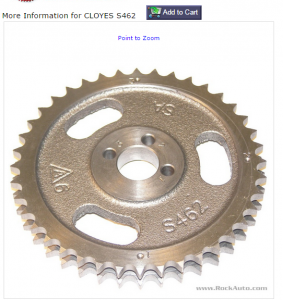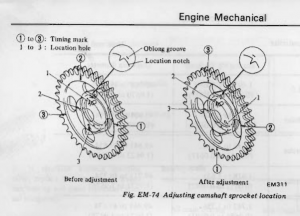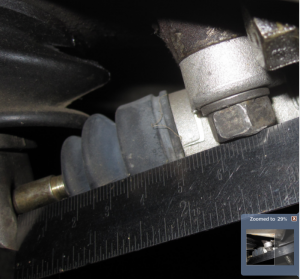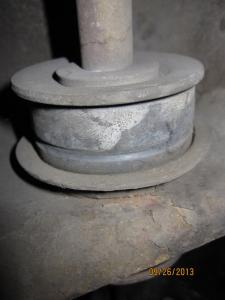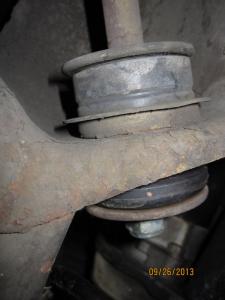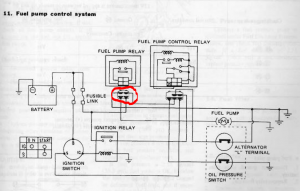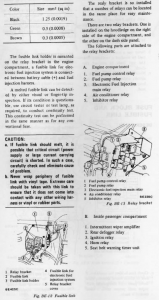Zed Head
Free Member
-
Joined
-
Last visited
-
Currently
Viewing Topic: Spendy eBay parts
Everything posted by Zed Head
-
L26 blowing back through the carburator
Maybe that "8" is a "6". Sure looks like an 8. Here is the Cloyes Datsun part. Looks like yours. Pretty sure that I've read that the Cloyes sprockets don't have the notch.
-
L26 blowing back through the carburator
The numbers do look good. Check your sprocket to make sure it has the notch. It looks aftermarket, the factory sprockets have four holes, yours has three. Some of the aftermarket sprockets don't have the notch. If it doesn't have the notch, what will you use to reposition the sprocket? Oddly, S-482 comes up as a Toyota sprocket on the Google. And it's much easier to check ignition timing than to remove the cam sprocket. You might be getting ahead of yourself. Do the easy stuff first. Eventually, if you want to be sure on cam timing, just buy a new sprocket, with notch.
-
Totaled my 240z
If the doors still open and close correctly, and the gaps are even, it might be a fairly simple repair. The unibodies are pretty stiff.
-
L26 blowing back through the carburator
Here are some answers from his other thread on Hybridz. - "I'll definitely be adjusting the valves. The mechanical timing seems OK from what I can tell so far. I guess I need check the crank sprocket to be 100% sure since I have no idea whether the pulley is the original one or not. The ignition timing would be really hard to do given that the car won't idle. That's pretty much my goal at this point - to get the car to idle enough to check things out with a timing light. The distributor is from a 280ZX. I guess I forgot to mention that. I'm going to check the compression as soon as I get a chance. That should at least allow me to rule out a valve if the compression is OK. As for the lobes, I don't see anything that jumps out at me as far as wear goes, but I'm not ruling out anything at this point. "
-
Poor Gas Mileage - '77 280Z
I think that emissions control was a big part of fuel injection development. With an adjustable FPR and some tricks I can get low 20's mileage on my engine. But at the sacrifice of mid-range performance. Tunability is the major benefit of carbs, compared to old EFI systems. But the newer aftermarket tunable EFI will probably beat them both. I get about 21 mpg mixed highway and city in the summer, and 18 in the cold of winter. With things set for performance. There are several parts that could cause low mileage, like out-of-spec. injectors, a coolant temp. sensor on the high end of the resistance range spec., an ECU on the high end of the injector open time spec., an AFM on the high end, stuff like that. The easy way to increase mileage is to use an adjustable FPR. Then you can move the whole fuel enrichment curve down. The problem is finding an adjustable FPR that is as good as the stock ones. They all leak down and cause a new aggravation. I modified a $34 Bosch FPR but that takes some fabrication work. Some of the California cars have an altitude switch that cuts enrichment by about 7% (I think). If I had a CA car and it was rich, I'd short that switch and put the ECU in lean-mode. Just one possibility. Overall though, carb tuning is probably easier and quicker.
-
clutch 240z
The transmissions from around 1971 up to 1983 are all the same, as far as the slave cylinder and clutch fork pivot relationship. That picture is from my 280Z, and it's an aftermarket slave cylinder so it looks different. But the distance from the mounting bolts to the end of the fork, at rest, should be the same for all of the Z car transmissions in that range of years, regardless of year or model.
-
Hard Shifting into Reverse
The one "trick" that always works but can be embarrassing if not done just right, is to put pressure on the lever while slowly letting the clutch pedal up, The gear will eventually move just enough to let the gears mesh. But, if the clutch grabs too quickly, you get a grind or a ka-chunk. It's odd that the problem came up with the oil change but maybe the Redline lets the non-synchro reverse gears gears snag each other, rather than sliding past to mesh. Maybe an unintended consequence of better synchro perfromance. Reverse is just jamming two gears together.
-
What To Do With 75 280Z
Another thought - daily driving an investment is scary. If it's worth a lot, it will probably sit in the garage. A Z that's not worth a bunch is more fun to drive, I think. And leave in a parking lot while you shop. Investments have to be managed to retain value. On the other hand, if you wait long enough, the 75 will probably increase in value. So time-frame has to be considered.
-
No Vacuum At Throttle Body Ports
On the throttle body. Check page EF-39. There's only two.
-
Removing Tail Light Housing - How?
The "rivets" on the top have a small plastic dowel in the center. That dowel has to be pushed through the rivet to allow the part on the other side to collapse and squeeze back through the hole. Usually, every part of that operation is difficult, the dowel will be stuck, the other side won't want to collapse, and it will be hard to get under the edge of the rivet to pry it up and out of the hole. Then, when they're finally out and the part is removed, you have to search all of the cracks and crevices for the little dowel. But that's how it's done. But, to get the tail lights out, you also have to remove the inner panel and remove a bunch of small nuts on long studs. Then carefully pry the light housing off of its old weatherstripping. In concept, it's quick, simple, and easy. In practice, things happen. THEN, to get the black part off of the lens and chrome so it can be painted, there are more tiny Phillips head screws. That will also be problematic.
-
clutch 240z
Here is a measurement from my car with the clutch pedal at rest. You can see that the boot on the slave cylinder is not stretched out like yours seems to be. You might have a short throwout bearing collar inside when you need a tall one. Take the same measurement that I show, with no pressure on the pedal, and see how it compares.
-
Triple Webers on 1977 280Z
Many carb people don't run vacuum advance. It goes away when you hit the throttle anyway. Even the early 280Z's (75-77, I think, definitely not 78) with EFI don't have vacuum advance until they're in top gear. There's a switch and solenoid that lock it out. Actually that might be the part you don't understand, you might have the top gear switch. Vacuum advance adds a little pep at part throttle, and some fuel efficiency but doesn't do much when the throttle is opened at low RPM. Have you measured initial timing? Confirmed that centrifugal advance works? Adjusted the valves? Every little bit helps, in addition to carb tuning.
-
What To Do With 75 280Z
Get it running. Sell it. Buy an early 240Z and make it your daily driver. The 240Z's are much better investments. 280Z's are great fun for a hobby and just driving. On getting it running - take the valve cover off and make sure the valves are closing. Squirt more oil in the cylinders, you might have surface rust jamming a ring or something. If you think the cylinder is messed up, it won't hurt much to run it on 5 cylinders.
-
Two steps forward,one step back. T/C rod length quandy
You could also cut the front bushing down and shim the back side out. Just a thought, same result. Here's an odd thought- the soft rubber bushings that Nissan used gave what is, effectively, an adjustable-in-use caster setting. Under braking, caster decreases, no braking, it goes back. Going to poly in front loses that. Probably depends on whether you're turning or going straight if it's a good thing or a bad thing.
-
12v. switched source
From what I've read, some of the electric fans pull a lot of amps. You'll probably need a dedicated wire and relay for it.
-
No Vacuum At Throttle Body Ports
The vacuum advance is controlled by "ported" vacuum. The port in the throttle body is closed when the throttle is closed. That might be why you didn't get any vacuum on that port. Most ports on the throttle body are "ported" or controlled by the throttle plate. Some may be direct though. But you can verify by cracking the throttle and feeling with your finger. If there's only vacuum when the throttle blade is open, that's one for the vacuum advance. Also, on the early 280Z's there is an electrcial solenoid that also stops vacuum unless you're in top gear. 1978 doesn't appear to have that though.
-
A better Auxilary Air Regulator
As described, it just lets air past the throttle blade. As long as it closes to the same spot consistently it doesn't matter much unless idle speed can't be controlled with the idle screw. Are you trying to solve a problem? Even in warm weather, the extra minute of high idle speed is convenient. The concept works, that's why it has stuck around so long and Chickenman has a modern part to do what the old parts did.
-
Cam cleanliness
How many miles have been put on that cam since it was shined up? That's the real issue, isn't it?
-
Distributor Mount, anybody have one they can part with?
The avatars don't blow up like a regular attachment does. Wish they would but they don't, and you can't really see them, they're small. Plus, there are three different distributor mounts, from 240Z to 280ZX.
-
Two steps forward,one step back. T/C rod length quandy
How about rim offset? Your wheel seems to extend outside the fender well. Also, on the poly/rubber bushing combination, poly goes in front and rubber in back. But that would probably make your problem worse since the rubber would compress and the poly wouldn't, effectively making the TC rod longer, in-use. Something I've never really considered before. But that's the way people do it, it stiffens up the suspension under braking when the arm is pushing the rod back in to the frame and the poly bushing. But leaves soft rubber on the back of the rod end, removing the bending load, which I think is why they break when poly is used front and back (which I had when mine broke). Here's some pictures I took a while ago. Are your washers set up like these? Rim offset, plus wide tires, plus a backward washer might push your wheel edge turning radius in to the fender. Edit - in the picture, the nut at the end of the rod is a second, locking Nylock nut. When I had poly on both sides the extra stress would loosen the single nut. I've been paranoid ever since.
-
Two steps forward,one step back. T/C rod length quandy
Another thought - since you may not have looked at the stock assemblage of parts for a while, is it possible that you left the big washer off of the back? This would allow the small washer and nut to pull through the rubber bushing, letting the wheel move forward. When I broke a TC rod, the inner control arm bushing was flexible enough to allow the wheel to move all the way forward inside the wheel well and rub on the inside of the well. That's what it did after the bump in to the curb when parking broke the rod. http://www.carpartsmanual.com/datsuns30/DatsunZIndex/Axle/FrontSuspension/tabid/1729/Default.aspx
-
Two steps forward,one step back. T/C rod length quandy
You know the wheels aren't centered in the well right? Compare the gap to the back wheels with the wheels straight. They look fairly normal in your pictures. I run a 205-70-14 which should be 25.3", with stock parts, and no rubbing, although there's barely a finger's width available when the wheels are turned. But, your 205-50-16 should be 24.1". So, there is something odd going on. Are you sure you're not running a 60 series tire? 25.7". Maybe you left a part in the bushing cup in the frame and it's pushing the rod forward. Pretty sure all of the TC rods are the same.
-
280Z Difficulty starting
I have Vol. 231 TSB for the 1976 280Z, and the collected TSB's, January - December 1979 for all Nissans, and can't find any reference to it. Can you post a copy? Memories are fallible, that's what paper (now computers) is/are for. I'm surprised that something so common and easily perfumed by a customer isn't documented in any of the FSM's or Owner's Manuals. Just seems strange. Any factory-published reference to it would be good to see.
-
280Z Difficulty starting
He said it's a 1978 model. Post #1. May have changed later but I didn't run through all of the pages. Fuel pressure is a funny thing. If your lines and filter and parts in between the pump and FPR are stiff, it will drop rapidly. If they're flexible and can store pressure, it can live on for a while. Considering all of the potential causes that seemed reasonable but weren't the cause, I'm in process-of-elimination mode. If the pump is fully powered while the key is turned to Start and it still has starting problems, then move on from all fuel pressure-related cusses. If a surprise happens and the engine starts up every time, then we'll come up with ten new reasons that fuel pressure would drop during starting. Since I have a nice multimeter and like to use it I'd probably be measuring various things to make sure the ignition system is strong and providing good spark. I think that I mentioned my weak ignition module theory way back in a previous page, along with various descriptions of how low voltage causes weak spark. I probably would have wired in a GM HEI module by now, because I like redundancy anyway (that's how I ended up with one on my car now). But, only one thing can be done at a time. So, a paper clip in the pump relay is simple and quick, therefore - why not?
-
280Z Difficulty starting
The control relay and the pump relay are both in the engine bay under that cover. There's a diagram on page BE-6 (edit - went ahead and added that picture too). I don't know how comfortable you are with wiring but a jumper wire at the connector (circled in the attached drawing) should run the pump just fine and completely bypass the control relay. A paper clip might do the job but make sure it doesn't touch any metal. It's connected directly to the battery and could short. As soon as you jump it the pump will run. While you're there, take a look at the control relay. If it's dirty and corroded it might need a good cleaning. They can be disassembled. But try the jumper wire first, that will tell the story on the control relay quality. CO might have some comments. He has dug much deeper in to the system. I'm suggesting this because it would be easy if you don't mind playing with electricity. A few screws, remove a plug, add a paper clip. More knowledge.




